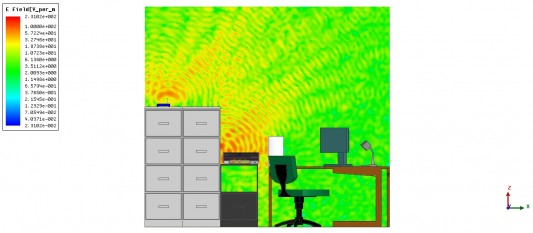The NSF-funded project seeks more reliable WiFi.
Gonzaga University is using Ansys engineering simulation software as part of its research into next-generation smart antennas for WiFi. The small Jesuit university in Spokane, Washington—better known for basketball—recently received nearly $1.2 million from the National Science Foundation to develop a Smart Antenna and Radio Laboratory, in part to investigate more reliable high-bandwidth wireless communications via Wi-Fi.
One of the Gonzaga research projects is aimed at overcoming the growing problem of wireless signal interference, as many users try to communicate simultaneously over the 2.4GHz band used for WiFi. The smart technologies developed by the team—headed by electrical engineering professor Steven D. Schennum—will enable antennas to focus on one user signal at a time. For example, for a WiFi user working on a laptop with a weak or cross-polarized signal, a smart antenna system would utilize algorithms to optimize the signal to that individual laptop.

The NSF grant provides Gonzaga with funding for dedicated computers running Ansys software that simulates smart antenna circuits and electromagnetic fields in three-dimensional structures. Using engineering simulation, Schennum and his team will develop new multi-antenna techniques that improve both the efficiency and bandwidth of wireless communications.
Schennum says the use of simulation software is critical in bringing these intelligent technologies to market both quickly and cost-effectively. “We’re creating a state-of-the art anechoic chamber for testing our physical antenna prototypes, but even the best antenna test chambers are limited in their size and shape, the performance of their absorptive materials, and the range of frequencies they can accommodate,” Schennum says. “By simulating electromagnetic fields and currents in a virtual environment using Ansys software, we can test the performance of our antenna designs for any location, plane or geometry—and over a limitless range of frequencies—before moving to the prototype stage.”
Schennum also says engineering simulation supports a higher level of innovation and greater flexibility during the design process, enabling researchers to run countless what-if scenarios. HFSS and DesignerRF from Ansys are being used at Gonzaga to provide results at a system level—including fabricated metal parts, cables and other components—to capture the effect of individual changes on how the antenna system performs as a whole.
“The antenna design laboratory has the potential to impact millions of wireless communications users around the world—starting with Gonzaga’s students learning about the benefits of engineering simulation,” says Markus Kopp, product manager for electronics at Ansys. “The radio spectrum is a highly valuable resource. In the past, researchers have used advanced engineering principles to identify ways we can use that spectrum much more efficiently. Smart antenna technology is the next step in that continuum.”





